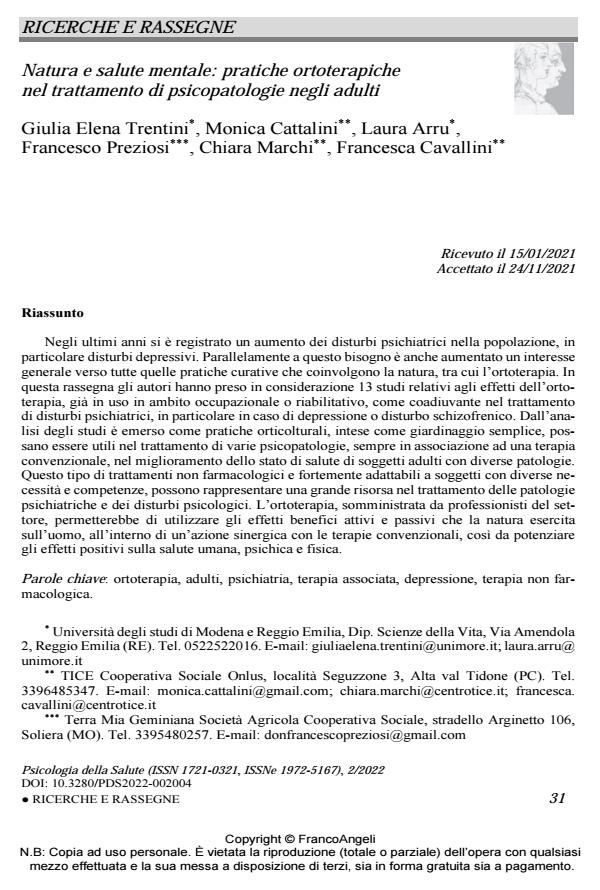Natura e salute mentale: pratiche ortoterapiche nel trattamento di psicopatologie negli adulti
Titolo Rivista PSICOLOGIA DELLA SALUTE
Autori/Curatori Giulia Elena Trentini, Monica Cattalini, Laura Arru, Francesco Preziosi, Chiara Marchi, Francesca Cavallini
Anno di pubblicazione 2022 Fascicolo 2022/2
Lingua Italiano Numero pagine 24 P. 31-54 Dimensione file 312 KB
DOI 10.3280/PDS2022-002004
Il DOI è il codice a barre della proprietà intellettuale: per saperne di più
clicca qui
Qui sotto puoi vedere in anteprima la prima pagina di questo articolo.
Se questo articolo ti interessa, lo puoi acquistare (e scaricare in formato pdf) seguendo le facili indicazioni per acquistare il download credit. Acquista Download Credits per scaricare questo Articolo in formato PDF

FrancoAngeli è membro della Publishers International Linking Association, Inc (PILA)associazione indipendente e non profit per facilitare (attraverso i servizi tecnologici implementati da CrossRef.org) l’accesso degli studiosi ai contenuti digitali nelle pubblicazioni professionali e scientifiche
Negli ultimi anni si è registrato un aumento dei disturbi psichiatrici nella popolazione, in particolare disturbi depressivi. Parallelamente a questo bisogno è anche aumentato un interesse generale verso tutte quelle pratiche curative che coinvolgono la natura, tra cui l’ortoterapia. In questa rassegna gli autori hanno preso in considerazione 13 studi relativi agli effetti dell’ortoterapia, già in uso in ambito occupazionale o riabilitativo, come coadiuvante nel trattamento di disturbi psichiatrici, in particolare in caso di depressione o disturbo schizofrenico. Dall’analisi degli studi è emerso come pratiche orticolturali, intese come giardinaggio semplice, possano essere utili nel trattamento di varie psicopatologie, sempre in associazione ad una tera-pia convenzionale, nel miglioramento dello stato di salute di soggetti adulti con diverse patolo-gie. Questo tipo di trattamenti non farmacologici e fortemente adattabili a soggetti con diverse necessità e competenze, possono rappresentare una grande risorsa nel trattamento delle patolo-gie psichiatriche e dei disturbi psicologici. L’ortoterapia, somministrata da professionisti del settore, permetterebbe di utilizzare gli effetti benefici attivi e passivi che la natura esercita sull’uomo, all’interno di un’azione sinergica con le terapie convenzionali, così da potenziare gli effetti positivi sulla salute umana, psichica e fisica.
Parole chiave:ortoterapia, adulti, psichiatria, terapia associata, depressione, terapia non farmacologica.
Giulia Elena Trentini, Monica Cattalini, Laura Arru, Francesco Preziosi, Chiara Marchi, Francesca Cavallini, Natura e salute mentale: pratiche ortoterapiche nel trattamento di psicopatologie negli adulti in "PSICOLOGIA DELLA SALUTE" 2/2022, pp 31-54, DOI: 10.3280/PDS2022-002004